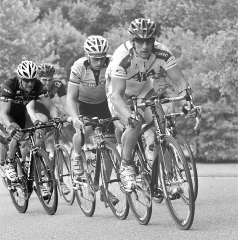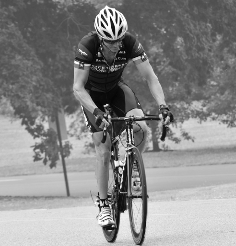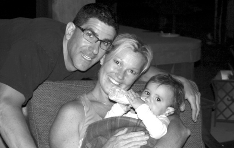The difficult thing about bicycle racing is the volume. The levels get turned up on everything: that rider drifting in on your left, the curb on the right, the small crack in the road, the weather, the climbs, the sound of your gears clicking down one at a time in the midst of the churning pedals around you. In that much noise, in that echo chamber of competition, it gets tough to figure out what is worth hearing and what should be left behind as a distraction. I had a heart attack at a bike race. I never heard it coming.
Now before you glaze over, before you turn down the volume on the rest of my story, understand this, I’ve been that guy. I like things to be dialed in a certain way. I like to succeed. I like goals and work and the challenges that accompany life lived to the fullest. I’ve ignored stories like this as “other-peoples’ issues.” So hang on a second. Don’t think this is something that you should just glaze over. It isn’t. It’s your life, or your brother’s, your sister’s, your husband’s, wife’s or partner’s, your children’s, your parent’s, or your friend’s. This is important for you. Heart disease is the number 1 killer in America. Over 500,000 of those are MIs. Half of those are folks with NO (0, none, zilch) risk factors, many have NO symptoms. I’ll quote a few terrifying statistics and numbers later, hang with me a second in Kentucky. Yeah, Kentucky.
It’s fitting that I had a heart attack in Kentucky. Birthplace of the Colonel’s extra crispy secret recipe, and headquarters to Texas Roadhouse Restaurants, you’d think you could have a heart attack just through contact with Kentucky culture, but on that hot, July day in Louisville, the scene was lycra shorts, electrolyte drinks, hyper-fit athletes and cardiovascular fitness that would make, the famed race horse, Secretariat proud. I was in Louisville, for the 2008 Masters National Road Race- a collection of amateur, and professional athletes denying age and time.
In addition to volume and noise, bike races are filled with possibility, an addictive and seductive thing. Midway through my race, I’d been feeling somewhat mediocre, yet I wasn’t ready to sign off on the possibility of winning. With five laps to go on the twelve-lap course, possibility arrived and I chased it. This circuit through a parkway in downtown Louisville had lots of noise. The rolling hills, false flats, steep climb and double bump before the finish with beautiful green tree limbs hanging over most of the course like a canopy, came at you like a rock concert. I knew this course well as I’d been here before. When a group of riders moved up in our pack on one of the hills, ready to spring off the front, I saw the move going, and decided this was important noise. I jumped and followed the wheels. A former pro rider and national champion was attacking and I was there on the rivet, barely hanging on.
 We had a small gap over the next few rollers and through the lap. Riding in a pace-line, our effort was hard and fast. We drilled it and for a second it seemed we might create the gap, the key distance to break away from the pack. I looked back. The pack was returning. Our effort was not enough to get away and we got hauled back in by the bunch. No big deal. This happens a lot.
We had a small gap over the next few rollers and through the lap. Riding in a pace-line, our effort was hard and fast. We drilled it and for a second it seemed we might create the gap, the key distance to break away from the pack. I looked back. The pack was returning. Our effort was not enough to get away and we got hauled back in by the bunch. No big deal. This happens a lot.
I readied myself for a brief rest and then more noise, more attacks, more separations. As I had pulled through for my turn at the front, I was lacking power. The power that I’d had just moments before was suddenly gone. Someone unplugged me. Suddenly there was no volume and no possibility. It was odd.
I drifted back in the group looking for recovery over the crest and down the backside and onto the flats. As I continued to slip back, I just kept waiting for the power to kick back on. It didn’t and when I looked up, I saw the field, the whole field, turning the corner to head up the steep climb, fifteen to twenty seconds in front of me. I didn’t expect that! I did my best to pull through and work with the guys I was with, guys who had also fallen off the pace from the main group. We kept falling further and further behind the race. I was dropped. Things got really quiet. One final push to separate myself from the chase group with three kilometers to go, and I crossed the finish line alone and took inventory.
 I was disappointed, but consoled myself with the mantra of the beaten athlete, “best I could have done.” Then I thought about my family, the fourth of July plans with my wife and our young daughter. Mostly, I felt badly.
I was disappointed, but consoled myself with the mantra of the beaten athlete, “best I could have done.” Then I thought about my family, the fourth of July plans with my wife and our young daughter. Mostly, I felt badly.
A feeling of dread crept over me. I felt badly about the race, but increasingly worse about my upset stomach and the taste in my mouth, a buzzing metallic taste. I felt worse about how my friends, Tracy and Curtis Tolson, were looking at me. What they were saying seemed distant and small.
“What’s the matter with you?” “You don’t look so good.” “Do you feel like you’re going to throw up?” “You need to get an EKG on him.” “Y’all need to get an EKG on him right now!” “Go get Mandrola.”
I wasn’t totally aware of it but Tracy sent Curtis to find Dr. Mandrola, a cardiologist who could read the printouts from the 6 and 12-lead EKG’s indecipherable to the EMTs. This was a big deal because when the cardiologist started to speak, that was noise I could hear.
“Get this guy to the hospital- what’s he doing here?!”
I was still looking for a phone to call my wife when they put me in the ambulance. I was still trying to sort out what was happening when they gave me nitroglycerine.
Isn’t that for heart attacks?
I’d only seen it in movies and near as I can figure, the movies are pretty accurate: When the guy clutches his chest, looks ashen and contorts his face in pain, I feel a lot worse for him now. I don’t know if I did all of that, but I could have. It hurt. A lot. It was like no other.
Myocardial Infarction doesn’t sound significant enough. When the doctor told me that I had “suffered an MI”, I blinked and responded, “Isn’t that like a heart attack?” Heart attack is so much more severe and important. Call it an MI or a heart attack, it is a deep hole. For me there was nearly no bottom- it is a very quiet place with only one question repeated for hours, days and months at a time. Am I? Am I going to get through this? Am I ok? Am I going to ride again? Am I going to be healthy enough to watch my daughter age and grow?
I can tell you about the recovery because I’m lucky. If Tracy hadn’t demanded the Cardiologist & the EKG… If I’d been alone on a training ride somewhere… If….
There were many small steps back. I got the clearance to walk, then ride. There were heart rate and blood pressure limitations. I took medicine, necessary medicine. There exists a slow, never full, release of fear’s grip on everything I do. More importantly, I want to talk about how I wasn’t aware. Not at all. I wish I’d known about the things I’m pointing out below. But I wasn’t aware.
MI aware? Yes I am! I am now. I check for symptoms. While working out, or racing or after a race I sit and continue taking inventory of sensations that may be warning signs. Moreover, I feel like I’m in a place to help people who might not see this coming. Half of all heart attacks happen to people with no risk factors. (I told you I’d get into the stats, and I was one of them.) 25 million people are living with heart disease in America and it is still the #1 cause of death in the US killing over half a million people every year. Much of it is avoidable.
Knowing simple health-related facts about yourself like a faMIly history, cholesterol, and blood pressure are a start. Get extended cardiovascular blood testing to accurately understand your cholesterol profile, inflammation markers and genotype predisposition. Stay active to avoid diabetes, obesity, and to push off stress. Smoking, as you might expect, is bad. If you have two or more of these risk factors you should consider having your Coronary Flow Reserve checked with a PET scan. It is the most accurate test for diagnosing Coronary Artery Disease which may lead to a Heart Attack.
Finally, know the symptoms of MI. It is like a bike race, it isn’t clear which noise is important to hear- so hear these signs clearly: Chest discomfort anywhere from just below your rib cage to the top of your collarbone (on either side) that lasts more than a few minutes or comes and goes is a bad sign as is uncomfortable pressure, fullness, squeezing or pain. Pain or discomfort in one or both arms, jaw, neck or stomach, shortness of breath, nausea, lightheadedness or a cold sweat. Finally, there’s the feeling of impending doom: that was the part in my story where I didn’t know if I could make it another minute, and just wanted to be home with my wife and daughter.
That’s pretty much it. Know those things. Complete the tests, and create a prevention life style. Stay in shape, eat healthy, and take cholesterol lowering medicine as directed by your doctor. Get a copy and read Dr. K. Lance Gould’s book, “Heal Your Heart”, and visit the Weatherhead PET Imaging Center’s website www.uth.tmc.edu/pet/ for the most advanced non-invasive heart disease detection technology available. Additionally, challenge your doctors to complete extended cardiovascular blood testing to see your true cholesterol picture, inflammation factors and genetic traits. Visit www.bhlinc.com for information about Berkley Heart Lab’s suite of tests and follow-up consultation.
I’m 42 years old, I’ve had a heart attack and I’m racing again. I notice slightly different things now, but the sounds of riding are the same. I can still hear things from my race in Louisville, but the noises are clearer, more interminable, I know what I’m trying to hear. Am I perfectly recovered? Not yet. Am I grateful? Yes. Am I aware? I am now.
I hope you will be too.
Founder, MI Aware, Inc.– A Heart Attack Awareness and Prevention Initiative

